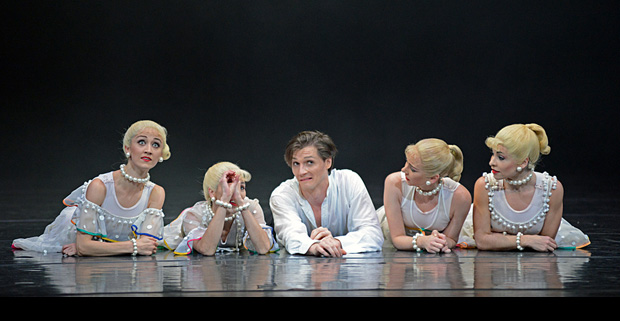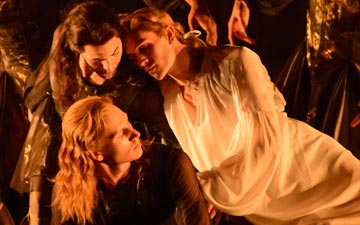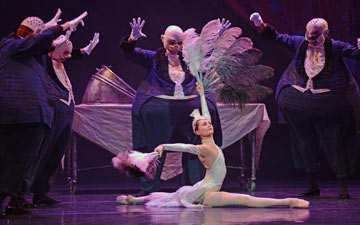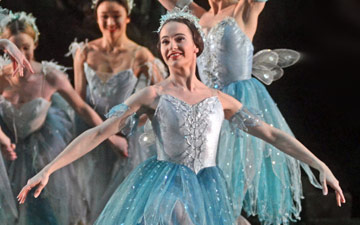
© Dave Morgan. (Click image for larger version)
Birmingham Royal Ballet
Serenade, Carmina burana
London, Coliseum
19 March 2015
Gallery of pictures by Dave Morgan
www.brb.org.uk
www.eno.org
To celebrate his 20th year as artistic director of Birmingham Royal Ballet, David Bintley has revived the first work he created in the post – Carmina burana, set to Carl Orff’s cantata of the same name. It involves most of the dancers in the company, unlike its companion piece in the Coliseum programme, George Balanchine’s Seranade, a homage to the female corps de ballet.
BRB’s women dance Serenade well, in what used to be regarded as a very English style: neat feet, plenty of epaulement in the upper body, arms and wrists unstrained. They’re not as dynamic as Balanchine-schooled dancers, though two of the leads, Momoko Hirata and Celine Gittens, move expansively: fearless Hirata has a high-flying jump, and Gittens is glorious as the guardian ‘Dark Angel’. In supporting roles both men, Chi Cao and Tyrone Singleton, are elegant, discreet.
Tchaikovsky’s Serenade for Strings gives way to Orff’s cod-mediaeval chanting after the interval, with the Ex Cathedra choir singing from boxes on either side of the proscenium arch. The sound is thunderous. The opening racket invoking Fortuna, Empress of the world, reverberates around a solitary, blindfolded woman (Samara Downs) semaphoring from an empty stage overhung with crucifixes. She’s foretelling the fate of those who lose or betray their faith.

© Dave Morgan. (Click image for larger version)
Three seminarians stand out from a crowd of rebellious red-wigged priests, all too ready to rip off their dog collars and experience the delights of the flesh. The first to have a go, Jamie Bond, finds himself among a gaggle of fecund women, clutching pregnant bumps and multiple babies. Their simple routine is replaced by rural merry-making on a grand scale, with bouncy boys and folk-dancing girls. Four flirty blondes trot in like show-ponies to charm and bemuse Bond and his fellow novices. He falls for Elisha Willis (happier as a soubrette than as a soulful Serenade ballerina), who jilts him in favour of having fun. He’ll learn to be less trusting.
The second seminarian, Mathias Dingman, a troubled man on the run, flings himself into a roiling solo of virtuoso rage. But just as Bintley’s choreography becomes challenging, it is overtaken by a silly number for gluttonous men devouring a showgirl swan. The episode makes no sense at all unless the Latin words of the song for a falsetto tenor are understood. Dingman is then mugged by an aggressive gang of red-wigged thugs in black suits – seminarians gone bad. He gets what’s coming to him.

© Dave Morgan. (Click image for larger version)
The third failed priest, Iain Mackay, ends up in the sensual hell of Venusberg, with Downs as the soul-destroying goddess. She is fiendish carnal love, reducing Mackay to his designer underpants as he aspires to partner her in a dance of death. The crucifixes from the opening scene now appear to be dripping blood as the orgy becomes ever-more sinister: the ‘O Fortuna’ anthem returns to celebrate a Black Sabbath. What Bintley has described as a ‘modern-day morality play’ ends in eternal damnation.

© Dave Morgan. (Click image for larger version)
Carl Orff, Bintley and his designer, Philip Prowse, know how to work on an audience’s sensibilities, stunning most of its members into compliant enjoyment. It seems not to matter that the music-theatre action, like the dog Latin libretto, is largely incomprehensible and far too long. Hardly an ideal choice to commemorate Bintley’s two decades of choreography for BRB, though there are other programmes on tour throughout the year to show off his range and that of his dancers.

















You must be logged in to post a comment.